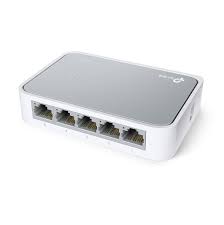TP-Link TL-LS1008 8-Port 10/100Mbps Desktop Switch
TP-Link TL-LS1008 8-Port 10/100Mbps Desktop Switch delivers straightforward network expansion for homes and small offices requiring additional Ethernet connections. This compact desktop switch transforms a single network port into eight functional connections, enabling multiple devices to share internet access seamlessly.
Technical Specifications and Performance
Network Connectivity Features
The TP-Link TL-LS1008 operates on Fast Ethernet standards, providing consistent 10/100Mbps data transfer speeds across all eight ports. Each port supports auto-negotiation, automatically detecting connected device capabilities and adjusting transmission speeds accordingly.
Key technical attributes include:
- Port Configuration: 8 x 10/100Mbps Auto-Negotiation RJ45 ports
- Switching Capacity: 1.6 Gbps full-duplex bandwidth
- MAC Address Table: 1K entries with automatic learning and aging
- Data Buffer: 96KB shared memory for efficient packet handling
- Power Consumption: Maximum 2.2W during operation
Installation and Setup Process
Setting up the TP-Link TL-LS1008 requires no technical configuration or software installation. The plug-and-play design means connecting your router to any port and powering on the device immediately activates all network functions.
The switch automatically learns MAC addresses and builds forwarding tables without user intervention. LED indicators provide real-time status information for power, link connectivity, and data activity across all ports.
Practical Applications and Use Cases
Home Network Enhancement
Transform your home networking setup by connecting gaming consoles, smart TVs, desktop computers, and network-attached storage devices simultaneously. The TP-Link TL-LS1008 eliminates the need for wireless connections where Ethernet provides superior stability and reduced latency.
Small Office Connectivity
Expand workstation connectivity in small business environments where additional Ethernet ports become necessary. Connect printers, IP phones, security cameras, and employee workstations through a single, centralized switching solution.
Design and Physical Characteristics
The compact form factor measures just 6.2 × 3.9 × 1.0 inches, fitting comfortably on desktops without consuming excessive workspace. The metal housing provides durability while maintaining efficient heat dissipation during extended operation periods.
External power adapter design keeps the unit lightweight and reduces internal heat generation. The fanless operation ensures completely silent performance, making the TP-Link TL-LS1008 suitable for noise-sensitive environments like bedrooms or quiet office spaces.
Energy Efficiency and Environmental Considerations
Power Management Technology
Advanced power-saving features automatically detect cable length and adjust power consumption accordingly. The switch enters low-power mode when ports remain inactive, reducing overall energy usage without affecting network performance.
Environmental specifications include:
- Operating Temperature: 0°C to 40°C (32°F to 104°F)
- Storage Temperature: -40°C to 70°C (-40°F to 158°F)
- Operating Humidity: 10% to 90% non-condensing
- Storage Humidity: 5% to 90% non-condensing
Quality Assurance and Reliability
Manufacturing Standards
TP-Link constructs the TL-LS1008 using high-quality components tested for long-term reliability. The switch undergoes rigorous quality control processes ensuring consistent performance across varying environmental conditions and usage patterns.
Warranty and Support Coverage
Each unit includes comprehensive manufacturer warranty protection covering defects in materials and workmanship. Technical support resources provide troubleshooting assistance and configuration guidance when needed.
Compatibility and Integration
The switch maintains universal compatibility with IEEE 802.3 and IEEE 802.3u Ethernet standards, ensuring seamless integration with existing network infrastructure. Compatible devices include:
- Desktop and laptop computers running any operating system
- Gaming consoles including PlayStation, Xbox, and Nintendo systems
- Smart home devices requiring wired connectivity
- Network printers and multifunction devices
- IP cameras and security system components
- Network-attached storage and media servers
Performance Optimization Tips
Network Layout Considerations
Position the switch centrally within your network topology to minimize cable lengths and reduce signal degradation. Avoid placing the unit near sources of electromagnetic interference such as microwaves or wireless routers operating on 2.4GHz frequencies.
Cable Management Recommendations
Use Category 5e or Category 6 Ethernet cables for optimal performance and future-proofing. Shorter cable runs provide superior signal integrity and reduced latency compared to maximum-length installations.
Properly organized cable management prevents physical stress on connectors and maintains clean airflow around the switch housing for efficient heat dissipation.


 No products in the cart.
No products in the cart. 
Reviews
There are no reviews yet.